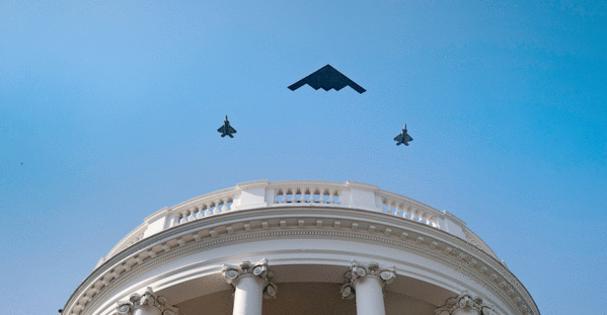Commentary: Billions for weapons, rather than troops, won't make us safer
Published in Op Eds
The Pentagon got a whopping $150 billion increase in the budget bill passed by Congress and signed by the president July 4. That will push next year’s proposed Pentagon budget to more than $1 trillion. Most of that enormous amount will go to weapons manufacturers.
A new report by the Quincy Institute and the Costs of War Project at Brown University found that for the period from 2020 to 2024, more than half of the Pentagon budget — 54% — went to private companies. That figure has climbed considerably since the immediate post-Cold War period of the 1990s, when the contractor share was 41%.
The surge of spending on the Pentagon and its primary weapons suppliers won’t necessarily make us safer. It may just enrich military companies while subsidizing overpriced, underperforming weapons systems, even as it promotes an accelerated arms race with China.
While weapons firms will fare well if the new budget goes through as planned, military personnel and the veterans who have fought in America’s wars in this century will not. The Trump administration is seeking deep cuts in personnel, facilities and research at the Veterans Affairs, and tens of thousands of military families have to use food stamps, a program cut by 20% in the budget bill, to make ends meet.
The $150 billion in add-ons for the Pentagon include tens of billions for the Trump administration’s all-but-impossible dream of a leak-proof Golden Dome missile defense system, a goal that has been pursued for more than 40 years without success. Other big winners include the new F-47 combat aircraft, and the military shipbuilding industry, which is slated for a huge infusion of new funding.
The question of how to allocate the Pentagon’s orgy of weapons spending is complicated by the fact that there are now two powerful factions within the arms industry fighting over the department’s budget, the traditional Big Five, composed of Lockheed Martin, RTX (formerly Raytheon), Boeing, General Dynamics and Northrop Grumman, and emerging military tech firms such as SpaceX, Palantir and Anduril.
The Big Five currently get the bulk of Pentagon weapons spending, but the emerging tech firms are catching up, winning lucrative contracts for military-wide communications systems and antidrone technology. And there will be more such contracts. Even after the public falling out between Elon Musk and the president, the emerging tech firms have a decided advantage, with advocates such as Vice President JD Vance, who maintains close ties with his mentor and political supporter Peter Thiel of Palantir, and dozens of staff members from military tech firms who are now embedded in the national security and budget bureaucracies of the Trump administration.
Meanwhile, the tech sector’s promises of a new, revolutionary era of defense made possible by artificial-intelligence-driven weapons and other technologies are almost certainly overstated. If past practice tells us anything, it is that new, complex high-tech weapons will not save us.
The history of Pentagon procurement is littered with “miracle weapons,” from the electronic battlefield in Vietnam to Ronald Reagan’s “impenetrable” Star Wars missile shield to networked warfare and precision-guided bombs used in the Iraq and Afghan wars. When push came to shove, these highly touted systems either failed to work as advertised, or were irrelevant to the kinds of wars they were being used in.
Just one example: Despite the fact that the Pentagon spent well over $10 billion to find a system that could neutralize improvised explosive devices in Iraq and Afghanistan, only modest progress was made. Even after the new technology was deployed, 40% of I.E.Ds could not be cleared.
Technology is a tool, but it is not the decisive factor in winning wars or deterring adversaries. An effective military should be based on well-trained, well-compensated and highly motivated troops. That means taking some of that 54% of the Pentagon budget that goes to contractors and investing in supporting the people who are actually tasked with fighting America’s wars.
But to be truly safe, we need to fight fewer wars by adopting a more realistic strategy that emphasizes diplomacy and close cooperation with allies, and that resorts to force only when there is a major, direct threat to U.S. security. A more balanced strategy would be much less likely to put U.S. troops in high-risk situations like the nation-building efforts in Iraq and Afghanistan.
Instead of letting corporate special interests distort our foreign and military policies, we need to press for an approach that puts strategic considerations first. That will mean taking steps to reduce the power of the arms makers, new and old, through steps such as stronger measures to limit the revolving door between government and industry.
And we need to bring more independent voices into the Pentagon’s budget discussions. Lockheed Martin, Palantir, SpaceX and other companies shouldn’t have undue influence over decisions on how much to spend on our military, and what to spend it on. That’s no way to make a military budget, and no way to defend a country.
____
William D. Hartung is a senior research fellow at the Quincy Institute for Responsible Statecraft and the co-author, with Stephen Semler, of the report “Profits of War: Top Beneficiaries of Pentagon Spending, 2020 to 2024.”
_____
©2025 Los Angeles Times. Visit at latimes.com. Distributed by Tribune Content Agency, LLC.

























































Comments